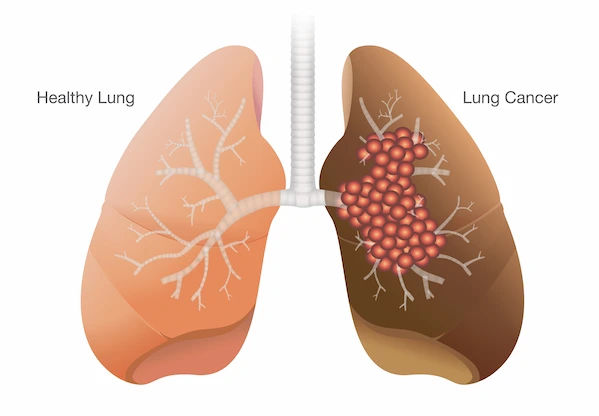Breast Cancer: Symptoms, Stages And Treatment Of Breast Cancer
Explore the risks, symptoms, and treatment options for breast cancer. Learn how early detection and awareness can improve outcomes and support better health.

Written by
Last updated on 3rd Jul, 2025
Breast cancer is one of the most common kinds of cancer impacting people worldwide, primarily women but also a small percentage of men. It develops when abnormal cells in the breast begin to grow uncontrollably, forming a tumour that may be benign or malignant. While significant progress has been made in treatment and survival rates, early detection remains the most powerful tool in fighting this disease.
The sooner breast cancer is identified, the greater the chances of successful treatment, which is why awareness, routine screenings, and understanding personal risk factors are so important.
Understanding Breast Cancer
Breast cancer is not a single disease but a category that includes various subtypes, each requiring specific treatment approaches.
Invasive Ductal Carcinoma (IDC): The most common form, beginning in the milk ducts and spreading to surrounding tissue.
Invasive Lobular Carcinoma (ILC): Develops in the milk-producing glands, sometimes making detection difficult through standard mammograms.
Inflammatory Breast Cancer (IBC): A rare but aggressive form that does not always present with a lump; instead, it causes redness, swelling, and warmth in the breast.
Triple-Negative Breast Cancer (TNBC): Lacks estrogen, progesterone, and HER2 receptors, making it more challenging to treat with hormone therapies.
HER2-Positive Breast Cancer: Involves overexpression of the HER2 protein, leading to rapid tumour growth but responding well to targeted therapies.
Understanding these subtypes helps guide treatment plans, ensuring personalised care for each patient.
Symptoms of Breast Cancer
Breast cancer symptoms vary widely, and while some people notice clear warning signs, others experience subtle or no symptoms at all.
Early Signs to Watch For:
A new lump in the breast or underarm
Changes in breast size, shape, or symmetry
Persistent pain in the breast or nipple
Nipple discharge, particularly if bloodyRedness, swelling, or dimpling of breast skin (often resembling an orange peel)
Advanced Symptoms:
Increased breast swelling or deformation
Retraction or inversion of the nipple
Unexplained weight loss and chronic fatigue
Persistent pain in bones or chest, suggesting possible cancer spread (metastasis)
Since breast cancer symptoms can mimic other conditions, it’s important to consult a doctor for any persistent or unusual breast changes.
Diagnosing Breast Cancer
Early detection saves lives. The sooner breast cancer is identified, the greater the chances of successful treatment.
Screening Methods:
Mammography: The primary screening tool that detects tumours before they can be felt.
Ultrasound: Helps differentiate between solid tumours and fluid-filled cysts.
MRI: Used for high-risk patients or dense breast tissue cases.
Diagnostic Tests:
Biopsy: A tissue sample is taken to confirm if cancer cells are present.
Hormone Receptor Testing: Determines if the cancer is estrogen- or progesterone-receptor positive, influencing treatment options.
HER2 Testing: Identifies whether the cancer overproduces the HER2 protein, which affects targeted therapy choices.
Routine screenings and timely diagnosis significantly improve survival rates by allowing for less aggressive and more effective treatments.
Stages of Breast Cancer
Breast cancer is staged to assess severity and guide treatment strategies.
Stage 0 (DCIS): Cancer cells remain confined within the ducts.
Stage I: A small tumour with minimal lymph node involvement.
Stage II & III: Cancer has spread to nearby lymph nodes but is still treatable with surgery, radiation, and chemotherapy.
Stage IV (Metastatic): Cancer has spread to distant organs, requiring long-term management rather than curative treatment.
Accurate staging helps doctors determine the best approach for each individual case.
Treatment Options
Breast cancer treatment varies depending on the type, stage, and patient’s overall health. Surgery is often the first step, with procedures ranging from lumpectomy (removal of the tumour while preserving the breast) to mastectomy (removal of the entire breast). Some patients opt for breast reconstruction after mastectomy, either immediately or in later stages of recovery.
Beyond surgery, non-surgical treatments play a critical role in eradicating cancer and preventing recurrence. Chemotherapy uses powerful drugs to destroy cancer cells, often administered before or after surgery. Radiation therapy targets and eliminates remaining cancerous cells in the breast, chest wall, or lymph nodes. Hormonal therapy is effective for hormone receptor-positive cancers by blocking estrogen’s effects, while targeted therapy focuses on specific genetic mutations, such as HER2-positive cancers.
Each treatment plan is personalised, considering factors like the patient’s age, cancer aggressiveness, and overall health condition.
Side Effects of Breast Cancer Treatment
While treatments effectively combat cancer, they can also cause physical and emotional challenges.
Physical Side Effects:
Chemotherapy: Hair loss, nausea, fatigue, weakened immune system.
Radiation Therapy: Skin irritation, localised pain, tissue stiffness.
Hormonal Therapy: Hot flashes, mood swings, joint pain.
Emotional & Psychological Effects:
Anxiety, depression, and emotional distress are common among patients.
Mastectomy and hair loss can impact self-esteem and body image.
Support groups, counselling, and mindfulness techniques help manage the psychological impact.
Comprehensive cancer care includes physical, emotional, and psychological support to help patients cope.
Lifestyle and Breast Cancer
Lifestyle modifications can reduce breast cancer risk and improve overall health during and after treatment. A balanced diet comprising fruits, nutritious vegetables, lean proteins, and lentils supports immune function and maintains a healthy weight, which is essential since obesity is a known risk factor. Limiting alcohol consumption and avoiding smoking also contribute to better long-term health outcomes.
Physical activity plays a crucial role in reducing recurrence risks and managing treatment side effects. Regular exercise, even gentle activities like walking or yoga, helps combat fatigue, improve circulation, and boost mood. Survivors who engage in physical activity have been shown to experience better recovery and overall quality of life.
Support and Resources
Navigating breast cancer is challenging, but patients do not have to go through it alone. Support systems, including family, friends, and survivor networks, provide encouragement and practical assistance. Many organisations, such as the American Cancer Society and BreastCancer.org, offer educational resources, helplines, and financial assistance programs.
For healthcare providers, staying updated on the latest breast cancer treatments and research is essential in providing the best care. Medical institutions and research centres continually develop new therapies and clinical trials, giving patients access to innovative treatment options.
Conclusion
Breast cancer remains a significant health challenge, but increased awareness, early detection, and advancements in treatment have led to improved survival rates. Routine screenings, lifestyle changes, and knowledge of risk factors can help in prevention and early intervention. Ongoing research continues to pave the way for better treatment options, bringing hope to those diagnosed with the disease. For anyone affected by breast cancer—whether personally or through a loved one—seeking timely medical advice, staying informed, and accessing support resources are crucial steps in navigating this journey with strength and resilience.
Consult Top Gynaecological Oncologists
Consult Top Gynaecological Oncologists

Dr Rani Bhat
Gynaecological Oncologist
20 Years • MBBS, MS (Obs & Gyn), MRCOG (UK), Fellowship in Gynae-Oncology (Singapore) Fellowship in Gynae-Oncology & Robotic Surgery (Hong Kong) Diploma in Gynaecological Operative Endoscopy (France)
Banglore
Apollo Cancer Centres HSR Layout, Banglore

Dr. Rupashree Dasgupta. Gynaecological Oncology
Gynaecological Oncology & Robotic Surgery
26 Years • MD(Gold Medalist, CMC Vellore), DGO(Gold Medalist, CMC Vellore),DNB, MRCOG(London), MBBS(FOGSI Gold Medalist in Gynaecology).Specialist in Advanced Laparoscopic & Robotic Surgery, UICC Fellowship in Gynae Oncosurgery(BARTS Cancer Institute, LONDON), da Vinci certified training as ROBOTIC CONSOLE Surgeon(USA), Fellowship Gynae Oncosurgery(TMC, Kolkata)
Kolkata
Apollo Multispeciality Hospitals , Kolkata, Kolkata
(350+ Patients)

Dr. Sai Lakshmi Daayana
Gynaecological Oncologist
18 Years • MBBS, MRCOG
Hyderabad
Apollo Hospitals Jubilee Hills, Hyderabad
(200+ Patients)

Dr Bhawna Garg
Gynaecological Oncologist
26 Years • MBBS, MS, (PGI MS ROHTAK) FELLOWSHIP GYNECOLOGY ONCOLOGY, (CANCER INSTITUTE CHENNAI)
Delhi
Apollo Hospitals Indraprastha, Delhi

Dr. Amit Choraria
Surgical Oncologist
18 Years • MBBS, MS (Surgery) Fellow, Surgical Oncology, Tata Medical Center (FSO) Fellow, European Board of Surgery (Surgical Oncology) (FEBS) Fellow, Minimal Access Surgery (FMAS) Fellow, Indian Association of Gastrointestinal Endosurgeons (FIAGES) UICC Fellow, Royal Marsden NHS, London, UK Visiting Scholar, Plastic Reconstructive Surgery, CGMH, Taiwan Fellow, Robotic Surgical Oncology, Vattikuti Foundation, USA
Kolkata
Apollo Multispeciality Hospitals , Kolkata, Kolkata
(50+ Patients)

